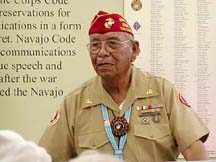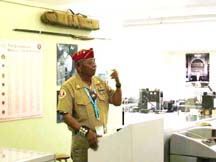|
C O D E T A L K E R
Featured speaker for the Computer Museum, August
15, 2002, Thursday evening is Joe Morris, Sr., Reservation born Dine'/Navajo,
who will describe his 1944-46 experiences as a code talker on Guadalcanal,
Guam, Saipan, Okinawa, and Tinstao, China.

|
There
is an overflow turnout at the Colman College Computer Museum main
hall of exhibits. In this group of enthusiastic supporters are Marine
Veterans, Electronic Industry professionals, students and tribal people
supportive of the recognition of our Tribal Warriors. Following Honorable
Discharge from the Marine Corps and return to the reservation, Morris
worked for the Railroad until his retirement. He and his wife Charlotte
live in Daggett, CA. |
Our speaker was born in 1926 and raised on the Navajo
reservation at Indian Wells, Ariz. He fudged on his age to obtain a draft
registration card and join the Marines in 1944 at the age of 17. After
passing physical and written tests in Phoenix, he was sent for basic training
to the San Diego Marine Recruit Depot, then assigned to the Navajo Communications
School at Camp Pendleton. There he was trained for five months in code
communication skills and terms for military hardware, battlefield sites,
and key officials.
| Morris and around 420 other
Navajo code talkers served in the U.S. Marine Corps during World War
II to fulfill the need the Allied forces had to communicate sensitive
information across the thousands of miles of ocean in the Pacific
Theater. Morris and the others used a code based on the Navajo language
to transmit vital communications with remarkable speed and accuracy
- using the only battlefield code never broken by the enemy. The code
was especially difficult since Navajo is a spoken language with no
reference to the terms that needed to be communicated. |
 |
 |
Furthermore,
for security reasons, the 500 or so terms in the code were not written
down, but needed to be memorized to be recalled at a moment's notice.
The Navajos solved that by adapting traditional words to suit their
new purposes. A submarine, for example, was called an "iron fish,"
and a helicopter was a "hummingbird." Letters were also used to spell
out terms, and to confuse the enemy further, the most commonly used
consonants and vowels in English were assigned several Navajo letters.
Because of such complexities, Navy cryptologists testing the code
tried in vain to decipher it. Even Navajos untrained in the code couldn't
break it. After serving as a code talker in some of the hottest battles
in the Pacific Theater, Morris was discharged in August 1946. His
awards include combat ribbons for the Pacific Theater and China Occupation
medals. He also holds a Rifle Expert medal, as well as certificates
of appreciation from both the President of the United States and the
California Senate. |
| This exhibit
caters to general history buffs and Code Talker fans alike, with as
much information as one would want. AIWA, American Indian Warrior
Association, member, Warren Brader is most supportive of the Computer
Museum and the positive image of the military. His expertise is often
sought out regarding the authenticity and chronology of various military
communication and encryption equipment.On loan to the exhibit are:
TBY-8 VHF Code Talker Radio. TBX-4A High frequency Code Talker radio.
GRC-109 Special Forces, CIA, Agents radio. PRC-64 Special forces FBI,
CIA radio. TG-5 Teletype. BC-611Walkie Talkie. KLB-47 Encryption unit.
GRA-71 Encryption Code Burst unit. |
 |
 |
All of the
radio gear on display is 100% complete and operational. The self-guided
exhibit shows that for most Code Talkers, their adventures began in
April 1942, when Marine 1st Sgt. Frank Shinn established a mobile
recruiting station near the government hospital in Fort Defiance.
The first 29 were inducted May 4 of that year at Fort Wingate. The
total number of Code Talkers is between 400 and 420. |
"There never has been an official list of Code Talkers
from the Marine Corps," said Joe Morris. One of the principal reason for
the lack of public information is the secretive radio operating missions
of the Code Talkers in the Pacific Theatre of World War II weren't declassified
until 1968.
All Photos property and courtesy of Warren Brader
|




